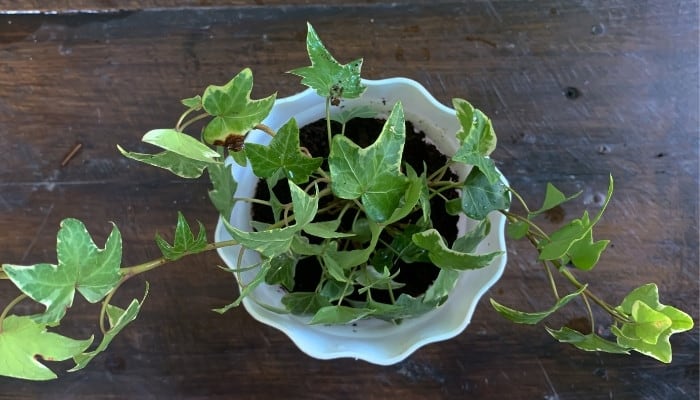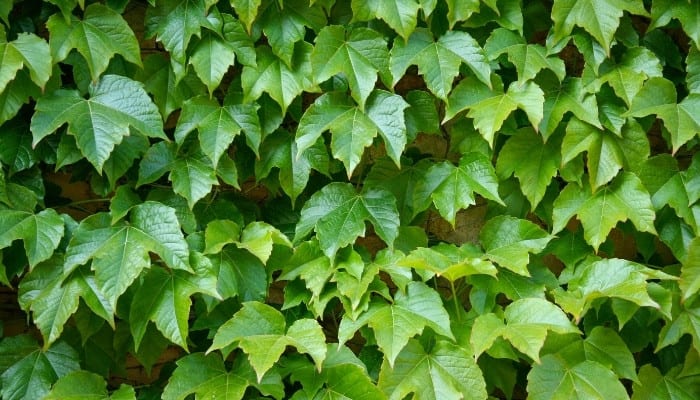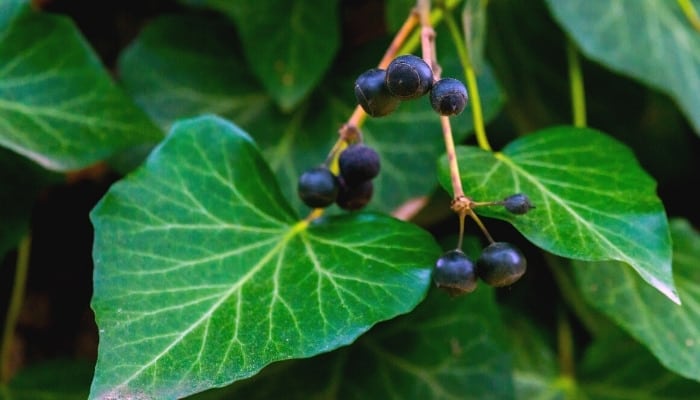The sight of Traditional English ivy reminds one of fairy tales, with its unbridled perseverance to decorate all that lies in its way.
However, its romantic aesthetic doesn’t veil the fact that this plant needs a diligent owner to grow it responsibly.
How do you care for English ivy? English ivy grown indoors does best in a fertile potting mix with temperature of 52–71°F and humidity greater than 40%. Provide bright, indirect light, water every 1-2 weeks, and fertilize monthly in spring and summer. Outdoors it is best grown in pots for control and will need routine pruning.
English ivy can be enjoyed on your coffee table or in your garden if you’re willing to control and train its lively growth.
The following care guide details how to keep your ivy happy, repotting steps, plus your common queries answered and more.
English Ivy Indoor Care
English ivy, aka “common” or “European ivy,” is known scientifically as Hedera helix, which roughly translates from ancient Greek as spiral and grasp, a fitting moniker for this mesmerizing, unruly vine.
With close attention to ensure its ideal growing conditions are met, English ivy can thrive in stand-alone pots to trail horizontally or look equally stunning in waterfall displays from hanging baskets.
English Ivy Care at a Glance
Ideal Soil for English Ivy
Choose a rich soil mix, preferably containing organic matter as this encourages drainage.
All-purpose commercial mediums like Miracle-Gro Indoor Potting Mix provide a balanced, formula that drains well.
Alternatively, make a potting medium of 1 part topsoil, 1 part peat moss, and 1 part perlite (organic granular material).
Peat moss and perlite work together to help the soil retain moisture while aerating it for effective draining – preventing overly moist conditions that can risk rot.
English Ivy Lighting Needs
Keep your English ivy in bright, indirect sunlight for best results.
It can lose its rich green color (or its pretty variegation in certain cultivars) in unbalanced light, so place it in windows that face north, west or east.
Homes with low light can use fluorescent lights, like these clamp grow lights with timers, to help their ivy thrive.
Passionate gardener and founder of the Plantophiles blog Marcel Iseli recommends using florescent lights in conjunction with “a light meter to give you a reading of the amount of sunlight provided.”
The following video demonstrates the different light strengths under grow lights and bright, indirect light from windows.
English Ivy Water Requirements
You’ll typically need to water your ivy every 1-2 weeks, and your unique home climate will determine the best watering frequency.
English ivy performs best in slightly dry soil, so ensure the top layer (about an inch deep) feels dry to the touch before each watering, and don’t allow the pot to sit in water collected in its saucer.
Temperature Ranges & Humidity Levels for English Ivy
An ideal temperature range for your English ivy is between 52–71°F (11-22°C) during the day and it will tolerate as low as 5°F (-15°C) at night.
English ivy will also thrive in humidity levels of 40% and above, but be wary of humidity dipping too low as this can attract pests.
Maintain humidity with regular misting or by placing your potted ivy plant on a pebble-water tray (learn how to make your own here).
It’s worth investing in a cool-mist humidifier, like this ultra-quiet model, to help your ivy out during winter too.
English Ivy Fertilization
Your English ivy likes to feed regularly to maintain its rich green color and healthy growth rate.
Heather Rhoades, from Gardening Know How, recommends applying a “nitrogen-rich, water-soluble fertilizer once a month from spring through to fall.”
Winter fertilizing is not necessary as the plant will be dormant and not feed; fertilizing in the winter actually risks damage to the roots.
Pruning English Ivy
Indoor potted varieties of English ivy tend to be “small-leafed, slow-growing and lower maintenance” compared to the outdoor kind according to the Home & Garden Information Center at Clemson University.
Simply pinch the vine just above a leaf or use clippers to keep your ivy to the desired length and prevent leggy stems.
Take care to always use protective gloves when handling your English ivy as the sap can cause skin irritation.
Repotting English Ivy

When first repotting your English ivy from its store-bought nursery pot, ensurethat its new container is wider than it is tall.
Self-described “plant mom” at Bloomscape and plant business owner Joyce Mast advises that shallow-style planters ensure the ivy’s naturally shallow root system has the space to spread horizontally rather than burrow deep, “as it will not thrive in deep soil.”
Your English ivy should be repotted every 2 years or once the roots appear to have filled the pot and are visible in the soil, becoming rootbound.
This is best done in spring to minimize stress.
How to Repot
- Clean & Fill a Pot 2 Inches Larger Than the Current Container With 1/3 Soil Mix
Select a new pot at least 2 inches wider in diameter than the existing pot to accommodate new root growth.
After washing it thoroughly, prepare your new ivy pot by filling it a 1/3 of the way with your desired potting soil mix.
- Carefully Remove the Plant From Old Pot & Gently Tease Roots From Current Soil
Using protective gloves, carefully slide the plant out from its existing container.
(You can turn the pot upside down and have someone catch the soil base if it is stiff, though watering 2 days prior should make removal easier.)
Once the base is exposed, gently loosen the soil around the root ball.
- Center the Root Ball in the New Pot, Add Remaining Soil & Water Well
Place your bare ivy plant in the new pot as centered as possible, positioning the top of the root ball 1/2 inch below the pot rim.
Pour in the remaining 2/3 of potting soil and gently tap the sides of the pot to eliminate any large air pockets in the soil.
Thoroughly water your newly potted ivy until you can see the water draining from the pot’s holes. Keep a saucer tray underneath to catch any excess and empty as necessary.
English Ivy Propagation
English ivy can be propagated (divided into offspring plants from your original ivy) by taking stem cuttings and growing them in damp potting mix or water:
- Take 4-5 inch Cuttings (With 2-3 Leaves on Each) During the Growth Season
Stem cuttings should be taken from mature ivy, so wait until the following spring from your time of purchase to propagate between spring and summer.
Using a sharp knife, take 4-5 inch (10-12 cm) stem cuttings, cutting below the leaf node, ensuring each cutting has at least 2 leaves.
- Remove Lower Leaves on Cuttings & Dip the Cutting Ends Into Root Hormone
Pinch off any leaves on the lower portion of your stem cuttings and dip the bottom inch of each cutting into a bowl of rooting hormone.
(Though not essential, rooting hormone can speed up root growth.)
Temporarily set aside your stem cuttings in a clear plastic bag to reduce water loss.
- Place Cuttings in a Small Jar of Water or Small Container of Potting Mix
Root your stem cuttings in a small jam jar half filled with water. Alternatively, you can place them in 4-inch flower pots filled halfway with a 50:50 ratio of peat moss and perlite.
Keep cuttings in indirect light and similar conditions as their parent plant.
- Change Water Weekly, Keep Potted Cuttings Moist & Repot When Rooted
Cuttings should start to form roots in 6-8 weeks in their respective containers. Change the jar water every week, or water potted cuttings weekly when the top layer dries out.
Well-developed roots should be 2-3 inches long, which is easily spotted in water.
For potted cuttings, Garden Guides contributor Joshua Duvauchelle recommends “gently tugging at the stem – if it resists you have roots!”
You can then plant your matured cuttings into small, wide pots of the same potting soil as your parent ivy plant, watering well to observe good soil drainage.
English Ivy Outdoor Care

Ideally, keep ivy in pots beside a wall or fence so you can easily train it to climb and control its size.
It grows best in a location that delivers 6 hours of full sun daily, but never grow them on a south-facing wall to avoid scorching.
For the first few months, water it enough to keep the soil consistently damp but not soggy, and once they have become established, water only once the top inch feels dry.
As for fertilizer, Bloomscape author Joyce Mast advises sprinkling the soil base with a “handful of basic houseplant food biweekly in warmer months then monthly as fall arrives.”
Is English Ivy Invasive?
English ivy can strangle nearby plants and burrow into building structures if unchecked, which is why this ivy is best contained in outdoor pots for better management.
Ivy typically spreads due to seed dispersal caused by birds eating the berries, but there is a non-invasive variety of English Ivy known as ‘Woerni‘ that does not produce viable seeds.
Does English Ivy Make a Good Ground Cover?
English ivy is an attractive, fast-filling ground cover that makes a great alternative lawn in small yards.
However, regular maintenance is needed to prevent takeover of local plants and walls, so if you don’t want the headache, consider crinkle-leaf creeper or western honeysuckle instead.
Controlling English Ivy Outdoors
English ivy will gladly spread up to 15 feet wide and over 50 feet high.
To control it, many growers on the Gardeners World forum advise consistently “cutting back the ivy at ground level until it runs out of energy.”
To completely eradicate problem ivy, Garden Guru and plant author Mike McGrath recommends severing the vines before “softening the affected area with water and digging out each vine’s root system using a poacher’s spade.”
English Ivy Varieties
There are over 500 varieties of English ivy which include ‘Goldchild’ ivy grown for its elegant gray-green foliage with yellow margins; ‘Ivalace’ featuring glossy, curled leaves; ‘Needlepoint’ with elongated pointed leaf lobes, and the broader ‘Duckfoot’ English ivy resembling a duck’s footprint.
English Ivy Growth Rate
Indoors, English ivy will start to show significant growth after the first 2 years, by which time you can expect it to reach up to 9 feet without pruning.
Outdoors, ivy takes around 3 months to become established as a wall climber or ground cover and will pick up growth speed the following year in perfect conditions.
Does English Ivy Flower?
English ivy produces small greenish-yellow/white blooms in its second year once it matures.
These flowers appear in clusters in the fall and eventually produce dark blue berries containing a toxic inner seed.

How Long Does English Ivy Live?
English ivy can last 5-10 years indoors or around 10 years plus when grown outside.
Left to climb and spread far using aerial roots in the wild, ivy can live for over a century, with the oldest English ivy on record living over 400 years according to the Weed Wise Conservation Program.
Is English Ivy Poisonous?
Both the foliage sap and berries are listed as toxic according to the ASPCA.
In its mildest form, contact dermatitis can occur, and when ingested, it may lead to the development of neurological disorders in children and abdominal pain and vomiting in pets.
Does English Ivy Clean the Air?
Research presented to the American College of Allergy, Asthma & Immunology in 2005 demonstrated that English ivy substantially reduced the number of airborne mold particles in the home.
It has also been classified as an air-purifying plant in a 1989 Clean Air Study conducted by NASA as it can eliminate formaldehyde and other toxins in the air.
Does English Ivy Stay Green in Winter?
As a hardy perennial vine, English ivy will retain its rich green color throughout winter as long as the soil remains moist.
In unstable mutations of English ivy varieties, some may lose their color variation and revert to green in the dormant winter period.
Can English Ivy Grow in Water?
You can grow English ivy in water indefinitely, but the roots will not thrive as well as in rich, organic soil.
For best results in water, use filtered/distilled water to eliminate possible fluoride and chlorine traces from your local water source.
Does English Ivy Attract Bugs?
Outdoors, English ivy’s thick cover provides a great hiding spot for spiders while the indoor kind can attract smaller pests like aphids and spider mites in warm, dry conditions.
Maintaining an ideal environment can help prevent infestations and spraying foliage with organic pesticide can deter most critters.
Why Is My English Ivy Dying?
Your English ivy plant can struggle when it has been over or underwatered, with the latter contributing to diseased roots and the former leading to nutrient-deficient soil and therefore dried-out brown foliage.
Always check that the soil feels moist, not soggy, and wait until the soil is dry before watering again.
Maintain humidity levels with weekly misting and ensure that both indoor and outdoor potted ivy have not outgrown the current container.
Conclusion
In summary, English ivy makes a stunning accent plant if you’re prepared to reign in its rapid outdoor growth; although if you’re less confident, this plant adds classic elegance to your indoor space.
While regularly monitoring its growth is essential, this plant is an otherwise low-maintenance vine that will flourish for years when kept in the above-mentioned ideal conditions.
Sources:
https://omysa.com/blogs/planting-101/how-to-care-for-your-english-ivy-plant
https://www.flowershopnetwork.com/blog/flower-plant-care/plant-care/english-ivy-houseplant-care/
https://plantophiles.com/plant-care/english-ivy-hedera-helix/
https://blog.gardeningknowhow.com/gardening-pros-cons/pros-and-cons-of-planting-english-ivy/
https://www.housebeautiful.com/lifestyle/gardening/a28701546/indoor-ivy/
https://www.gardeningknowhow.com/houseplants/ivy/indoor-ivy-care.htm
https://www.gardenia.net/plant/hedera-helix-english-ivy
https://jandclawncare.com/blog/the-dangers-of-removing-english-ivy-by-yourself/
https://www.shelterwoodforestfarm.com/blog/2019/2/3/non-invasive-english-ivy
https://www.gardenia.net/plant/hedera-helix-english-ivy
https://lancaster.unl.edu/hort/articles/2004/lowlighthouseplants.shtml
https://homeguides.sfgate.com/replant-ivy-inside-home-73622.html
https://jandclawncare.com/blog/the-dangers-of-removing-english-ivy-by-yourself/
https://www.hunker.com/12519560/how-to-repot-an-ivy-plant
https://hortnews.extension.iastate.edu/faq/how-can-i-propagate-english-ivy
https://www.gardenguides.com/106180-grow-ivy-cuttings.html
http://www.ecosystemgardening.com/english-ivy-most-hated-plants.html
https://weedwise.conservationdistrict.org/management/english-ivy
https://wtop.com/garden-plot/2019/03/get-to-root-of-problem-how-to-eradicate-english-ivy/
https://forum.gardenersworld.com/discussion/288844/ivy-out-of-control
https://www.webmd.com/allergies/news/20051107/english-ivy-fix-allergies

![English Ivy: Hedera Helix Indoor & Outdoor Care [Full Guide]](https://whyfarmit.com/wp-content/uploads/2021/09/English-ivy-in-red-hanging-basket.jpg)